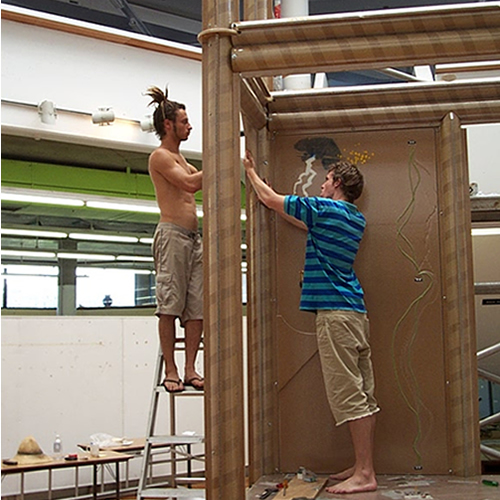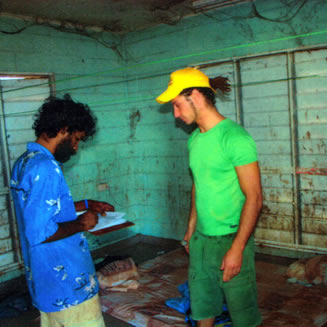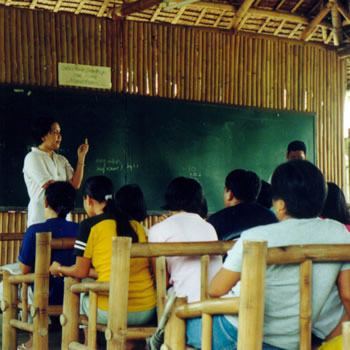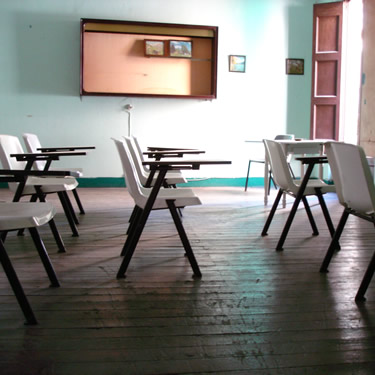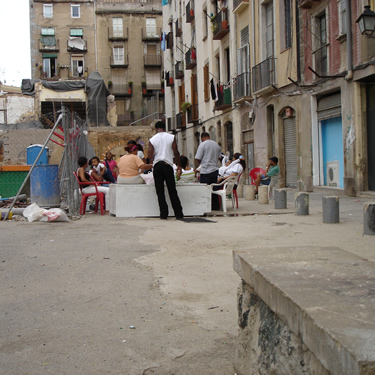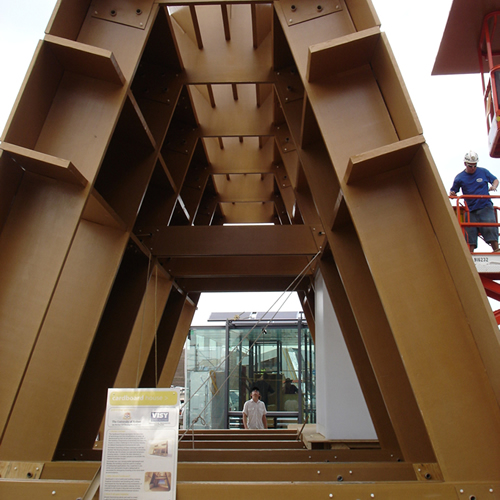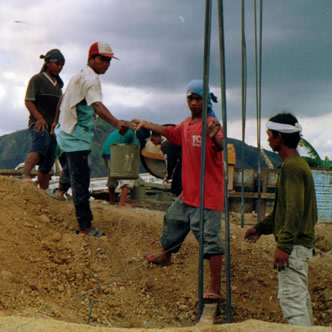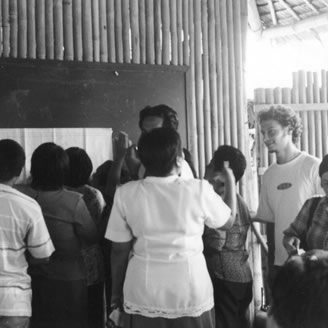Report From Winner
Adriano Pupilli, University of Sydney, Australia
Read winning proposal
Read Pupilli's biography
Notes
As my primary research objective was:
to explore issues facing Barcelona's displaced youth and the nature of self-help architectural solutions developed, looking specifically at: -the adaptation of borrowed/recycled space and materials and their role in housing the displaced. -the integration, interaction and role of these social housing alternatives within the surrounding urban fabric.
I am excited to say that on arrival to Barcelona I was met with much good fortune. Having had direct experiences of how several different groups of youth and young families recycle materials and spaces in order to create fully functional, socially sensitive, community integrated and environmentally sustainable self-help housing, I was able to closely study this process and its value to the practice of an ethical architecture, a global architecture, for displaced persons and communities in a local and global context.
Parallel to these explorations, an exploration of formal approaches to housing the displaced was also investigated in the form of visiting and researching several government housing projects in and around the City.
After 3 visits to the FORUM (FORUM BARCELONA) an interesting dilemma became apparent which I will explain in full in my report, but I must say that I was left quite confused by a dialogue of peace, cultural diversity and sustainability which was continually contradicted by what seemed obvious economic objectives of the venture.
It did leave me a good opportunity however to make parallels between how people organized the sharing and practicing of vital issues such as cultural diversity, peace and sustainability in respect to how the FORUM did.
As well as my street and homelife observations and participation I also got a chance to do some theoretical research. I visited Architetos Sin Fronteros (architects without frontiers) who were doing a lot of good work advocating for young squatters, I researched government housing in the National Library, and researched the FORUM in the Architectural Library.
Report
By Adriano Pupilli
Walking the old streets of Barcelona, a living breathing city, one cannot help sense the richness of the surrounding social and built fabric, as if it speaks of the people it serves, exuding their messages, ideas and dreams. A continual dialogue, an evolving architecture, which if allowed to flourish, tells the storey of people and place; present, past and future. Layers of flaking paint, stone and graffiti record time and events analogous to growth rings of tree-trunks or sedimentary layers of stone.
This universal dialogue, its development by people via the creative adaptation of urban built-form and the resulting inclusive elements of the city that have evolved will be presented to the reader for evaluation. These notes attempt to explore issues facing Barcelona's displaced, particularly youth, and the nature of self-help architectural solutions developed as a response, looking specifically at: the adaptation of borrowed/recycled space and materials and their function in housing the displaced, the integration, interaction and role of centros sociales or social centres within the surrounding urban fabric. Ultimately this paper seeks to initiate global dialogue on the implications of a human approach to the provision of affordable and sustainable housing in ones own city; investigating potential of this movement to alter non-ethical city development, architectural process and the architect’s relevance to a greater humanity.
Bien venidos a Karcelona1 one scrawls across a blank wall in the inner city, a simple message to passing tourists and locals alike. Another paints a delicate eye and a quotation on stone ruins, unos roban, otros matan por dinero…otros violan la educacion, destrui enpaises pobres….y yo me dedico a escribir textos!!2, presenting the importance of informal expression in keeping the actions of political leaders in check. Not far away a crowd gathers around a house covered in white sheets of paper masking taped to its facade. Coming closer one news feature reoccurs over and over accompanied by a page that tells passers by the plight of an immigrant family living in Barcelona, the letters plead against increasing measures by the city to attain regular immigrant fees. In response, a city treasury building is repetitively imprinted with the mark of hands dipped in red paint, accompanied by the message todos somos immigrantes, we are all immigrants. From a stone bench seat stencilled with the figures of riot police attacking a protestor, soldiers and bombs, passers by are made aware of underlying issues that politicians and the media dare not address.
These forms of expression greatly enrich the experience of inhabiting or passing through Barcelona’s built environments, however in some cases, go further to create an altogether new environment, by which people informally adapt an existing one. For example in the barrio of Gracia, community groups within each street organise an annual fiesta whereby inhabitants of each street collect an array of recycled CD’s, bottles, paper, milk cartons… assembling these materials in creative arrangement. Together with local musicians and actors who perform on makeshift stages, the community imaginatively transform their streets into diverse and surreal landscapes utilising local and renewable resources, each street competing yet complementing each other, the adapted built environment continually interacting with the bustling human traffic.
Importantly, the informal adaptations of the built environments discussed above, contribute enormously to the richness of the City fabric and its relevance to Barcelonan people; speaking to its inhabitants as inhabitants communicate in return, perhaps simply by the act of reading or choosing to ignore a message. However, the greater role of informal adaptation of borrowed/recycled space and materials in facilitating appropriate shelter solutions to displaced populations in the City also became apparent throughout field research in Barcelona, selected cases will now be discussed.
Placa de la Vergonya:3
Cuando vivir es un privilegio, Okupar es un Derecho4, found scrawled on a soon to be demolished building that is home to many migrant families in the old-city. Placa de la Vergonya is a soon to be developed and gentrified vacant inner-city block in the heart of the old-city La Ribera. In resistance to the development a group of poor and ethnic minority families gather to plant trees and garden beds edged in recycled bike wheels, install bench seats and playground equipment made from scavenged timber, put up information signs of their plight and move household furniture outside to inhabit the street and the ad hoc square. During the day older people sleep or people watch from the shade, in the afternoon and evening the square bursts with shouts from adults card games, kids playing and youth hanging out. While the fate of poorer residents is inevitable, the eventual displacement and relegation to one of many new public housing developments on the outskirts of Barcelona, this peaceful and innovative protest demonstrates a community’s ability to create a space that serves them. This movement, as with cases to be discussed, was in association with an organised network ofCasas Okupadas (squatted houses) called Assemblea d’Okupes de Barcelona.
Can Masdeu:
Salvem la Val, or Save the Valley was the cry local community members made when authorities unsuccessfully attempted to evict an assembly of squatters from the dilapidated Spanish villa after three months of occupation.Can Masdeu is situated in the hills north west of Barcelona, in close proximity to an area newly zoned for low-moderate income housing. Occupation of the privately owned building and land commenced in 2001 in protest to a development plan by local government to widen the adjacent housing zone into the valley where Can Masdeu sat proudly and disused for many years. Local residents, to escape cramped and dysfunctional conditions of their newly developed high-density apartment blocks, have inhabited the green-scape surrounding Can Masdeu for years.
This social centre or centros sociales provides more than just affordable, autonomous, self-help and sustainable accommodation to its young inhabitants, it provides a range of free neighbourhood support services such as; emergency accommodation, sustainable living workshops to school children, free-shop, political discussion groups, film nights and access to community fruit and vegetable gardens. The importance local residents place on this housing model and its role in serving the community was demonstrated recently when the property owner attempted to pass a development plan for a residential complex, however neighbours tenaciously resisted the proposal in court and won.
Having been lucky enough to call Can Masdeu home for most of my three weeks in Barcelona, I participated in a highly organised, democratic and sustainable way of living. The old villa was given new life as an eco farm by utilising: available waste products such as plastic barrels and old hose tube painted black to heat shower water, garden hose plumbing to connect the kitchen and bathrooms to nearby well-water using efficient siphon methods, solid human waste to fertilise the organic garden beds that provide food to house residents and neighbours, recycled food discarded by supermarkets at the daily close of business, elaborate composting and recycling operations, solar ovens to bake bread and daily meals, pedal powered clothes drier and sound system to save power, a bicycle workshop, and pot scourers made of twine from the garden. By adapting the existing building fabric, landscape and available resources that otherwise would have been discarded, a variety of environments that are directly appropriate to occupant needs have been achieved.
Le Castillo:5
My first night in Barcelona, I touch down from a 25 hour flight, walk around town and meet some travellers. By the end of the first day I am fortune enough to have found myself at an occupied house in the hills southwest of Barcelona. Similar to Can Masdeu, situated in an area zoned for low-income housing, Le Castillo was a disused property prior to its occupation by its current and fluctuating traveller population. In many respects it differs fromCan Masdeu in terms of its comparative lack of cohesion and organization due to the transient nature of its inhabitants, and perhaps because of the disparity between occupant age, social and cultural groups; occupants as varied as a young Catalan family with a small child to young adult travellers from all over Europe to single middle-aged adults who have migrated from the south of Spain.
Similar to subsequent cases, Le Castillo differs from Can Masdeu and Placa de la Vergonya as it is occupied with the consent of the property owner, although details of the arrangement were not attained due to the short period that I resided there. Despite the disputes for leadership and the fact that the home does not function as a social centre like that of many others investigated, the benefits of the autonomous, occupant-adapted and affordable accommodation is evident through the freedom that occupants exude; freedom from financial burden, freedom to personalise their space, freedom to interact with people of diverse cultures.
Anarko Piena Cultural
Walking up a small lane from Placa de la Vergonya a small pink sign stopped me: Tienda Gratis or Free Shop. An oxymoron such as this commanded another glance at the building that it addressed. Anarko Penya Cultural is a highly socially and politically orientated social centre, providing free accommodation to its diverse inhabitants, importantly however, it also provides a most impressive array of free community services to the surrounding urban poor neighbourhood who are continually under threat of displacement due to inner-city development discussed earlier. Previously a theatre and ballet school before its abandonment many years ago, the building and its occupants now provide free language, painting and dance classes, gymnasium facilities, hold regular community theatre productions, political discussions, demonstration organizations and disco tech parties. Joseph, a young occupant of the house explains that “we have been in good terms with the twelve property owners over our two and a half years of occupation”, they are permitted to stay rent free due to major repairs they have performed on the house, recycling what was an unusable space into an affordable home and community nucleus. They now continue to repair and maintain the property as part of their agreement with the landlord tocaretake in exchange for its free use.
Cyber Forat
Across the street from Anarko Penya, Cyber Forat is an interesting example of space borrowing and material recycling. Set up by one person for the primary purpose to benefit the wider community, he also benefits from free autonomous housing. Cyber Forat housed in a soon to be demolished government owned building utilises old computers donated or discarded, reconfiguring them to provide free internet access to locals, travellers, young and old. Similar to Can Masdeu and Anarko Penya, Cyber Forat provides a meeting place for people to access and exchange information freely, and for activists to gather and organise.
Miles di Viviendas
A seven-storey apartment block awaiting development lay dormant until opportunistic youth, with few affordable housing options close to their place of work and study, decided to occupy the entire block. They adapted one floor as the water access level with functioning kitchen and bathroom by installing their own hosepipe plumbing system, while the other floors are a mix of private bedrooms and communal areas.
Like most of the other cases discussed, the Assemblea d’Okupes de Barcelona is an essential watchdog that provides an element of protection toMiles di Viviendas. Through its mighty organising arm, this assembly of squatters has the ability to access media and human support in the event of an eviction threat.
An unforgettable experience at Miles di Viviendas involved a regularly scheduled cine a la fresca6. Having negotiated the adapted intercom system that now required a string be pulled connecting to who knows what, weaving through the complex of hallways past decoratively painted communal spaces, I finally arrive on a terrace. Surrounded by overlooking apartment blocks, I look down to see an audience assembled listening attentively as a young Israeli activist stands in front of a suspended white bed sheet explaining her documentary prior to its screening. After the film, the adapted space was host to an extremely interesting discourse, unforced and coalesced by the informal space.
As one of the primary objectives of the Barcelona travel fellowship, I attended Forum of the Cultures Barcelona 2004 amidst the confusion of pro-Forum propaganda lining every streetlight, bus shelter, sponsoring fast-food and telecommunications outlet, versus anti-Forum messages and stencils sprayed onto walls, paths and over Forum logos and property. The Forums themes of peace, cultural diversity and sustainability appeared to be disjointed in the context of its apathy towards the war in Iraq, multinational corporate sponsorship, continual marginalisation of immigrants in Barcelona, regular violent evictions of social centres and occupied houses, inaccessibility due to high entry fees and its theme-park atmosphere. To be fair, my surroundings living with activists primarily responsible for the anti-Forum campaign, granting me access to literature from both parties, must be mentioned as both an aid and hindrance to the objectivity of these observations.
A Forum showcasing the complexity of the world’s people, habitats and their interaction with each other has the potential to be a great event, increasing global consciousness, leading towards cultural acceptance and peace. However after three visits to the Forum, the dialogue of peace, cultural diversity and sustainability shouted loudly by glossy brochures and banners littering the Forum, became lost by the contradicting and underlying economic objectives of the venture. Had objectives been clear and honest from the outset and the City’s people more involved in decision-making and brainstorming the Forum, perhaps it may have been a different species with genuine messages relevant to both Barcelonan and foreign guests.
However, the Forum did provide the invaluable opportunity to compare approaches to addressing displacement, ethical city development and sustainability in Barcelona. Grass-roots approaches, such as the adaptation of space and materials to house people affordably and with a high level of autonomy, delivery of education, support services and entertainment to the neighbourhood by community-run social centres, were compared with more formalised approaches used by the Forum and City.
Exhibitions linked to core Forum themes held at Fundacio Joan Miro, Museu d’Art Contemporani de Barcelona and Museu Picasso quite often had strained relationships to the Forum. Without doubt these venues provided guests with an environment high in visual stimulation, but prohibitation of physical interaction with exhibits and an intimidating and authoritarian ambience to gallery spaces resulted in a lessor educational experience. However, visitor interactivity with demonstrations at Forum grounds must be commended, in which passers by of all ages cannot help but be seduced to play a tune on a forest of suspended source pans, play with the interactive world radio or word language translator.
Additionally, formal approaches to housing and service provision for Barcelona’s displaced people were investigated through the National Library, the Catalan Institute of Architecture Library and field research. These studies revealed a pattern of increasing gentrification of inner-city areas and the rezoning of industrial and peripheral areas to affordable high-density housing. No real objective appraisals could be sourced on the performance of recent public housing, however observations prove that older placa style apartment blocks with fewer levels function better socially than newer high-rise apartments in which public space is void of life, socially dysfunctional and dangerous. The biggest deficiency of formalised housing to address the needs of displaced youth and migrants in Barcelona, apart from the obvious financial burden, is dislocation from the inner-city areas that sustain their financial, educational and social needs, and placement into a banal environment in which they can do little to adapt, personalise or own.
Architetos Sin Fronteros7 are worth mentioning as they are a non-profit non-government organization that have been acting as a social bridge, advocating between the assembly of squatters and Barcelona City Government for some time. For example in the case of social centre Cyber Forat, the involvement of Architetos Sin Fronteros was instrumental to successful negotiations with Government, allowing the continued use of the vacant property until it comes time to demolish. An indirect and unconventional architectural role proves to be more helpful to the occupant and local community than a prescribed built form. . “They have co-opted our discourse” says Albero, a resident of Can Masdeu, “it’s a comodification of our movement” wrote an activist and squatter opposed to the Forum8. Formalisation of the Barcelonan people’s grass-roots discourse into the Forums agenda may be viewed in two ways; as a mockery that devalues the approach or more likely as a concession by the City, a victory to the people.
The human movement presented by the case studies demonstrate a working alternative to the delivery of affordable and appropriate shelter to displaced youth of Barcelona. It became evident that other minority groups also depend on this form of community support and housing to survive in Barcelona, although not as prevalent. While social centres are not without any problems, at times suffering a lack of personal and tenure security, overcrowding and privacy, internal disputes regarding personal/cultural differences, these centres have demonstrated their capability to provide socially, financially and environmentally appropriate housing to occupants with essential elements not mirrored by formal models investigated. Importantly, their role as community nucleus was not emulated elsewhere, providing support services that retain a sense of bartering, sharing and dignity rather than a sense of shame in the receipt of a handout.
This discourse is presenting many questions to socially conscious architects, planners and engineers as it is undeniably altering the process by which the marginalised are choosing to be housed and supported in Barcelona, the architect’s role evolving to stay relevant.
The reader can decide whether human architecture is a feasible alternative to housing the displaced in ones own city. In Sydney Australia, a number of occupied buildings and social centres have demonstrated the potential of the movement to appropriately house students and artists, facilitated by an atypical architect’s role. At present I live in a form of legalised squat, whereby six university students have adapted a disused Emergency Response Depot to create a fully functional student house that provides occupants with social interaction, a great sense ownership and dignity. Architect Col James was instrumental during the negotiation process.
Architetos Sin Fronteros in Barcelona, architect Col James in Sydney,Homeless Peoples Federation Philippines in Manila are witnessed examples whereby professionals have chosen to accept and work with this human process to great effect, in varying cultural contexts. However, these professionals remain the minority. If formal methods of development and community support are to evolve to become less prescriptive, more resourceful with our cities finite resources and inclusive of all who inhabit our urban landscapes, a decentralised human approach seems a sensible solution. By utilising this process architects can begin re-establishing their relevance to serving a greater humanity, a relevance that too often seems lost in the race to submit proposals for the next luxury hotel or apartment block, importantly making a positive step towards ethical and sustainable city development, and the city as habitat for all.
1 Welcome to Car-celona.
2 One robs, others kill for money…others violate education, demolish poor districts….and I dedicate myself to writing.
3 Plaza of Shame
4 When living is a privilege, squatting is a right.
5 The Castle
6 Outdoor Cinema
7 Architects Without Frontiers
8 Indy News - Barcelona
|
|




